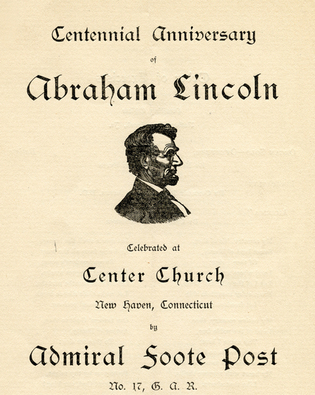 loading
loading
Old YaleThe Lincoln Tree and the bonesA tree, a storm, and New Haven’s original cemetery. Judith Ann Schiff is chief research archivist at the Yale University Library.  New Haven MuseumEvents commemorating Lincoln’s birth were held around the nation in 1909; this pamphlet announces a service at Center Church. Later that year, an oak tree was planted behind the church in Lincoln’s memory. Its uprooting last October reminded the nation that the Green used to be New Haven’s cemetery. View full imageA massive old oak tree on the New Haven Green, across from the Old Campus, was toppled by Superstorm Sandy on October 29. It was the historic Lincoln Memorial Tree, and the unfolding story of its loss and the discovery of the macabre contents revealed in its tangled roots captured the attention of the media and became Halloween headline news. On October 30, a passerby spotted a skull and partial skeleton in the upturned root ball; on closer examination by the state archaeologist, more bones were found. The skeletal remains—possibly representing two adults and two children—are now in the Yale laboratory of Gary Aronsen ’04PhD, a research associate in anthropology and archaeological studies, for further study. The remains represented a few among the thousands of interments that took place in the period when the Green, especially the area behind the First Church (now Center Church), served as the town burying ground—from 1638, when New Haven was founded, until 1797, when the Grove Street Cemetery was created. Once the new cemetery opened, some bodies were reburied there, but most were not. (Indeed, the Lincoln Tree was partially uprooted once before, by a 1961 storm, and a few human bones were found in its roots when it was replanted.) In 1821, the tombstones remaining on the Green were removed, carried by a procession of Yale students to the cemetery on Grove Street, and arranged in alphabetical order along the north and west walls. But the earthly remains of a great number of New Haveners still rest undisturbed beneath the Upper Green, including those of many Yale alumni and affiliates. Among them, for example, are James Pierpont (1659/60–1714), the minister of the First Church and the principal founder of Yale; and John Alling, Yale’s third treasurer, who died in 1717, just after the college moved from Saybrook to New Haven. Detailed descriptions of burials during the final years of the old burying ground were recorded by Yale president Ezra Stiles, Class of 1746, in his diary. Many of the dead had succumbed to the epidemics that swept through the colonies in the mid-1790s. Stiles recorded in March 1794 that “Backus, a Freshman, was taken sick” and died the next day of “the Angina ulcerosa, aet. 17.… The Physicians judging it impossible to keep the Corps [sic] till tomorrow, the funeral of Backus was attended after Meeting.” When more students sickened, four with scarlet fever, students were terrified and petitioned for dismissal. But it was not until after Stiles had attended more funerals and he and his wife were themselves taken sick that he “released as many scholars to go home as were intimidated.” Later that year, in September, 27 New Haveners died of yellow fever. The many new graves in the Upper Green were what moved James Hillhouse, Class of 1773, to create the Grove Street Cemetery, the first planned corporate cemetery in America, if not the world. As for the tree itself, its planting in April 1909 was one of many events around the nation commemorating the centennial of Abraham Lincoln’s birth. Its site, above the town’s original graveyard, was chosen because the Connecticut State House had stood there from 1828 to 1889, and it was on the State House steps that public prayers had been held after Lincoln’s assassination. News articles about the April 9 planting ceremony noted that it was held on the old State House site, but made no mention of the graveyard beneath. They did print the poem of 15 stanzas composed and read for the occasion; it included the lines “Students from old historic Yale / Will under our tree friendship renew / And bless Yale’s founder Elihu.” This April, in another town-gown partnership, a new Lincoln Tree will be planted by Urban Resources Initiative, a nonprofit affiliated with the School of Forestry and Environmental Studies.
The comment period has expired.
|
|